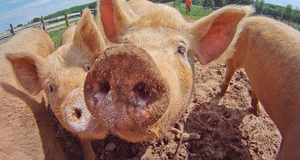Regulating GMOs in the United States and Europe: The Political and Economic Drivers Behind Monsanto's Agricultural Biotechnology Business
By
2014, Vol. 6 No. 08 | pg. 2/2 | « Stakeholder Analysis: A Beneficiary Behind the ScenesAs a response to increased awareness of bioengineered agriculture in the late 1990s, the EU preemptively blocked imports of bioengineered soy and corn, the majority of which were produced with Monsanto seeds. Much scholarly discourse credits the EU's refusal to purchase genetically modified (GM) soybeans from the U.S., by far the EU’s largest importer, as part of a protectionist policy to benefit domestic farmers who did not rely on GM seeds. Proponents argue that a protectionist policy of this sort has prioritized the interests of European farmers by giving them a competitive advantage against foreign competition. The structure of European farms, after all, are dissimilar to those of the U.S. EU farmers are organized in smaller, often family-run divisions that, unlike their larger American counterparts, benefit to a lesser degree from agricultural biotechnology. Whereas U.S. farmers might benefit from increased yield, such a phenomenon in the EU could trigger price decline due to massive overproduction. The likelihood of this theory thus remains low because it overemphasizes protection of EU farmers’ interest by EU policymakers. Rather, EU regulatory policy has historically given disproportional weight to consumer interests over farmer interests. The aftermath of the EU ban on GM soy was devastating for farmers on both sides of the Atlantic. Soy exports from the U.S. fell from $2.6bn to $1.0bn per year and corn exports dropped by $200m. The supposed competitive advantage that should have been enjoyed by EU farmers was, instead, offset by eliminating access to U.S. soy, a predominantly non-competing import. Like the U.S., which uses 98% of its soybeans for animal feed due to its high protein content, the EU also uses 80% of soybean imports for animal feed. Unlike the U.S., however, domestic production of soybeans throughout the EU is quite small, supporting a mere 6% to 12% of actual soy consumption (Vogel, 2001). EU farmers, thus, by all means benefit from cheaper, imported U.S. soy. From an economic perspective, GM soy is ideal not only because it benefits the bottom line by reducing supply chain costs for animal feed, but also because GM soy rarely ever reaches the end consumer in whole form. This ultimately indicates that EU farmers have not enjoyed a fiscal advantage, as many have been led to believe, from the elimination of Monsanto soybeans. Finally, throughout much of the early to mid-1990s many EU farmers advocated for increased use of bioengineered seeds. EU farmers argued for increased yield potential, self-sufficiency in soy production, and competitive advantages against foreign imports through biotechnology. Contrary to the protectionist theory, the EU was already self-sufficient in its production of corn. Banning bioengineered seeds thus had little effect on EU farmers since the majority of domestic corn demand was easily fulfilled. Despite potential detraction from farmers’ overall bottom line, EU policymakers mandated natural farming techniques—a phenomenon likely driven by the EU's multi-member makeup in which consensus is prioritized over unique, often divergent, interpretations of agricultural safety.Ultimately, it appears that EU farmers have adopted a preference for “natural” farming methods not out of a cultural favoritism for traditionalism, but rather due to commercial interests that mirror consumer preferences. Whereas France had historically pursued biotechnology as a driver of increased agriculture yield despite widespread fear that insect-resistant corn was harmful to consumer health, more than 50% of consumers in Sweden, Austria, Germany and 39% of those in the UK considered GM agriculture a serious health impediment by the late 1990s (McNichol, 2012). In deciding a coherent regulatory approach, the Treaty of the European Union (1993) ruling that mandated a precautionary interpretation of agriculture illustrates how consumer preferences, which drive demand for domestic production, are prioritized over corporations’ interest. The EU lobby by biotechnology multinationals such as Novartis, Rhone-Poulenc and Zeneca has been largely unsuccessful in overcoming public interest groups, NGO's and consumer opposition. EU retailers are similarly subject to shifting consumer interests more so than U.S. suppliers. Large corporations such as Iceland, a major UK frozen food producer, and Haldane Foods volunteered to label any GM sourced product, promoting transparency for the convenience of consumers in the purchasing process. This thus illustrates a trickling up effect in the supply chain whereby consumer interests influence farmer interests, which influence retailer interests and ultimately cause EU biotechnology corporations to adopt a modified, more conservative business model. Corporate Lobbying and Intellectual Property RightsThe U.S. has historically been one of the leading countries in rewarding innovation. Defense of intellectual property rights has been upheld countless times in order to spur creativity and defend pharmaceuticals companies that spend extensive amounts of money on research and development. A recent Forbes article titled, "The Planet Versus Monsanto," sheds light upon Monsanto's business model in which massive R&D investments are driven by cyclical royalties collected on leftover seeds from past seasons. Part of the controversy behind Monsanto’s patent on RR soybeans is due to Monsanto’s history of charging small farmers increasing variable prices once dependent upon Monsanto seeds – the only strain resistant to Monsanto’s proprietary Roundup pesticide. Because Monsanto management is obligated to seek the greatest return to shareholders, the firm’s actions are justifiable in a financial context, especially with regards to intellectual property rights. However, the Monsanto controversy illuminates a paradox in the U.S. political landscape in which defending intellectual property rights can actually create tension between policymakers' role as promoters of innovation and their role in defending public interest. After the publication of controversial studies warning of health hazards such as human hormone disruption, caused by Roundup Ready soybeans, massive consumer, farmer and retailer opposition against bioengineered agriculture ensued. Unsurprisingly, many of the policymakers and regulators in Washington who have dismissed claims against Monsanto hold pre-existing ties with the firm. Michael Taylor, former FDA deputy commissioner responsible for creating guidelines and restrictions on recombinant bovine growth hormone (rBGH), Monsanto's growth hormone for cows, was actually Monsanto's chief lawyer for seven years. Paul Wright, a toxicologist for Monsanto, led the U.S. study on health effects associated with polychlorinated Biphenyl (PCB's) in the private Industrial Bio-Test Labs of Northbrook. Here, data on glyphosate, the active ingredient in Roundup Ready used for Monsanto's soy, was falsified in numerous incidences of concealed deaths of lab rats. While the ethical nature of such practices reach beyond the scope of this paper, these instances indicate that Monsanto has successfully undermined the risk-averse mindset entrenched in the U.S. political landscape by pioneering agency capture and strategically supporting policymakers who can defend Monsanto’s interests in Washington. In the EU, however, corporations must successfully win favor of specific member states in order to influence any regulatory decision-making in the European Commission (EC). The EU divisions of multinational biotechnology corporations thus often enjoy a lesser degree of political freedom, and subsequently operate in a more stringent corporate regulatory environment. The possibility of agency capture in the EU is minimal because third parties must necessarily influence various committees at different stages in the regulatory cycle before actually implementing or blocking specific legislation. Because the vast majority of U.S. regulation is conceived in government-sponsored agencies, the differentiating factor between the EU and U.S. constitutional systems, with regards to corporate lobbying, lies in a revolving door, which allows the free flow of government officials in the and out of leadership positions for the industries their agencies are responsible for regulating. ConclusionMonsanto’s actions thus demonstrate how promoting an industry in a business context can necessarily entail minimization of its regulation. Regulatory failure of this type, exclusive to the U.S. political landscape, is ultimately what distinguishes the viability of Monsanto's bioengineered soy in the U.S. In order to move forward in the Monsanto debate, consumers, farmers, and policymakers must address fundamental regulatory divergences such as vulnerability to corporate lobbying and agency capture at the administrative level instead of attempting to alter Monsanto's business practices, as the firm’s actions will remain profit-oriented into the foreseeable future. It should be noted that the U.S. governmental system was enacted to protect both the interest of the public and corporations. If the U.S. regulatory system is failing to protect the public interest, then constituents should look to the political landscape in the EU in order to dissolve the evolving intimacy between Monsanto and U.S. policymakers. ReferencesCarr, Susan. "Journal of Risk Research." Journal of Risk Research. 3. (2000): 189-208. Web. 1 Nov. 2012. Damro, Chad. "Capture and Control: The Institutional Dynamics of EU Regulatory Independence." . University of Pittsburgh Department of Political Science, 2 2001. Web. 1 Nov 2012. "EU Regulation, Standardization and the Precautionary Principle: The Art of Crafting a Three-Dimensional Trade Strategy That Ignores Sound Science." . The National Foreign Trade Council, Inc., n.d. Web. 1 Nov 2012. Hammitt, James. "Precautionary Regulation in Europe and the United States: A Quantitative Comparison." . Duke Center for Environmental Solutions, n.d. Web. 1 Nov 2012. Kleinman, Daniel. "Aiming For the Discursive High Ground: Monsanto and the Biotechnology Controversy." Sociological Forum. 6.3 (1991): 427-447. Web. 1 Nov. 2012. Les, Levidow. "New Genetics and Society." New Genetics and Society. 18.1 (1999): 47-63. Web. 1 Nov. 2012. McNichol, Jason. "Multilateral Rulemaking - Transatlantic Struggles Around Genetically Modified Foods." Globalisation and Institutions: Re-Defining the Rules of the Economic Game. N.p.. Web. 1 Nov 2012. Palast, Gregory. "Dreaming in Monsanto." Index on Censorship. 3. (1999): 62-67. Web. 9 Nov. 2012. Patel, Rajeev. "Genetic Engineering in Agriculture and Corporate Engineering in Public Debate." Genetic Engineering in Agriculture and Corporate Engineering in Public Debate. 11.4 (2005): 428-436. Web. 1 Nov. 2012. Robin, Marie-Monique. The World According to Monsanto. New York, NY: The New York Press, 2010. 1-385. Print. Runge, Ford. "The Global Diffusion of Plant Biotechnology: International Adoption and Research in 2004." . Center for International Food and Agricultural Policy University of Minnesota, 8 2004. Web. 1 Nov 2012. Vogel, David. "The New Politics of Risk Regulation in Europe." . The London School of Economics and Political Science, n.d. Web. 1 Nov 2012. Vogel, David. "Shipps Passing in the Night: The Changing Politics of Risk Regulation in Europe and the United States." Robert Schuman Centre for Advanced Studies. EUI Working Papers, n.d. Web. 1 Nov 2012. Wiener, Jonathan. "Whose Precaution After All? A Comment on the Comparison and Evolution of Risk Regulatory Systems." n.d. Web. 1 Nov 2012. Endnotes1.) Excerpt from the National Foreign Trade Council Suggested Reading from Inquiries Journal
Inquiries Journal provides undergraduate and graduate students around the world a platform for the wide dissemination of academic work over a range of core disciplines. Representing the work of students from hundreds of institutions around the globe, Inquiries Journal's large database of academic articles is completely free. Learn more | Blog | Submit Latest in Political Science |


















